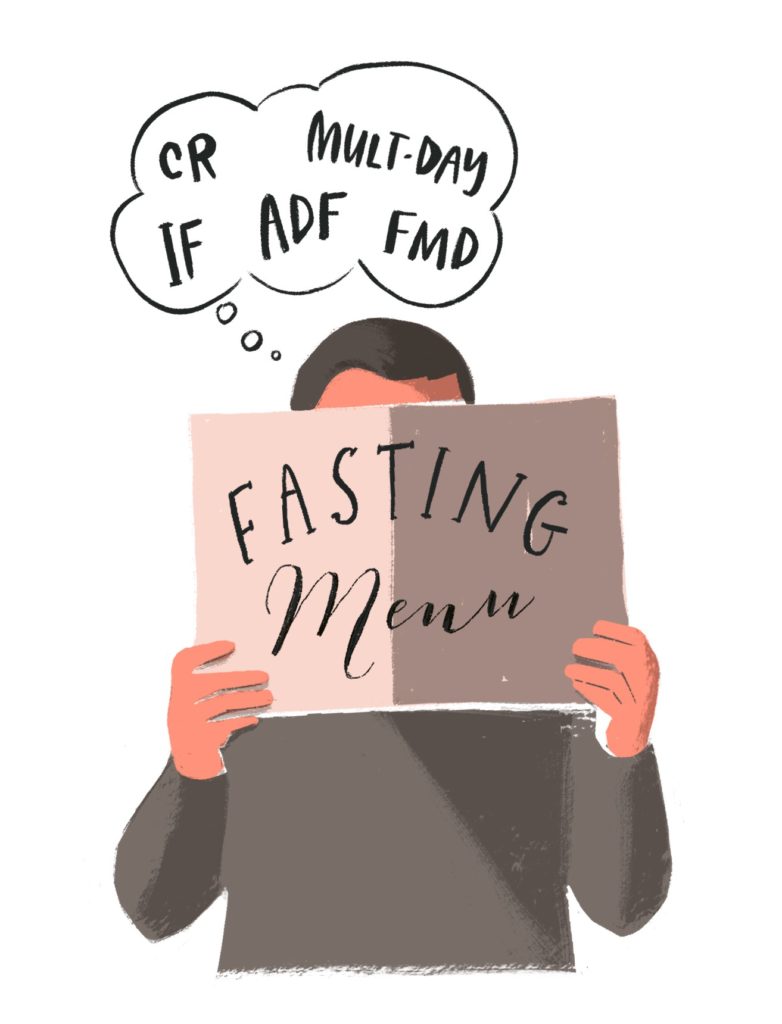Fasting is a rising trend right now, not only for its powerful weight loss results, but for a host of other health benefits that range from mental clarity to improved metabolic risk factors. Which fasting approach is right for you? Here’s a brief overview of six types (though you should always consult with your doctor before fasting).

Intermittent Fasting (IF)
How and when to fast varies by individual preference, health concerns, and medical clearance. However, intermittent fasting (IF) is gaining popularity for its ease and benefits. When we eat regularly, our bodies burn a simple sugar known as glucose for fuel. Fasting for around 9 to 16 hours (everyone’s different) depletes those glucose stores and begins to burn fatty acids known as ketones instead. This process is known as “ketosis” and it burns fat while preserving muscle mass. IF has been shown to improve cardiometabolic risk factors that lead to diabetes and metabolic disorders, improve cardiovascular health, increase longevity, and more.
There are many different variations on IF, including time-restricted fasting, where people eat only within certain windows of time that accord with their circadian rhythms. Many people prefer to stop eating after 7 or 8 p.m., fast through the night, and skip breakfast, sometimes known as the 16:8 plan. Women may not need to fast quite as long as men (approximately 14 hours for women to men’s 16 hours) to enter ketosis. Most plans recommend fasting a couple of times per week. But there are other variations, including the next one in this list, alternate day fasting (ADF).
Alternate Day Fasting (ADF)
Alternate day fasting(ADF) is a subset of intermittent fasting in which participants restrict all calories for an entire day, the “fast day” followed by a “feed day.” One recent study, comparing ADF to basic caloric restriction found that ADF is safe and comparable to caloric restriction (CR) in weight-loss — participants lost between 3% and 8% of their body fat — particularly stubborn belly fat. Additionally, studies point to ADF as a positive support for metabolic disorders and its risk factors. And the effects may not be temporary; for up to 24 weeks after undertaking ADF, the form of fasting was not linked to an increased risk of weight regain even without professional supervision. Add in endurance exercise and ADF may be almost doubly effective. Participants have reported that an ADF diet is easier to stick to than other forms of fasting because there’s no eating to tempt you on fast days.
Caloric Restriction
If you’re not sure that fasting is right for you, there’s always good old-fashioned caloric restriction (CR), reducing the number of calories you take in. In 1935, two researchers discovered that the simple act of reducing calorie intake in lab mice (without causing malnutrition) prolonged their lives by nearly double. This effect was also shown in other organisms, including worms, fruit flies, other rodents and primates. Studies have gone on to explore this effect in humans with promising results as well. To see benefits, humans must reduce their calorie intake by 40% to 60%. One study suggested that CR is “the only intervention known to date that consistently decreases the biological rate of aging and increases both average and maximal lifespan” in animal models. Researchers sought to understand why there are 4–5 times more centenarians (those 100 years old and older) in Okinawa, Japan than any other industrialized country. It turned out that there was record of a low caloric intake reported in school children on the island more than 40 years prior to the study.
Currently, a popular form of CR is the 5:2 Diet, popularized by British author Michael Mosley. Five days of the week you eat as normal, and for two days you restrict calories to 500–600 for the day.
Multi-Day Fasts
For the ambitious fasters who are medically cleared to do so, multi-day fasts may be the right route to go. Fasting expert Valter Longo, mentioned above, published a study in the journal Cellthat studied the affects of multi-day fasting on mice and humans. His research found that a multi-day fast of three days with zero to 200 calories per day reduced white blood cell counts, and encouraged the immune system to produce new white blood cells.
Longo theorized that fasting forces the body to recycle unneeded immune cells, with the help of an enzyme called PKA and a hormone called IGF-1, both of which increase with fasting. When participants begin to eat again, stem cells replenish the cells that were recycled. Of course this sort of fasting can be more mentally challenging, but the results may be worth the struggle.
Fasting-Mimicking Diet (FMD)
For those who just can’t face total fasting without some kind of food, the fasting-mimicking diet might be right for you. Fast mimicking diets essentially “trick” the body into believing it’s fasting while you still eat food, albeit a reduced amount of calories. A typical FMD lasts about five days (though it can go for much longer) and aims for a balance of carbs, protein, and calories, leaning toward foods that are high in fat. Participants take in about 40% of normal calorie intake. A popular form of FMD is the “Keto diet.”
A growing body of evidence also indicates that the FMD brings numerous health benefits. A study published by the Longevity Institute at the University of Southern California’s Leonard Davis School of Gerontology, led by Professor Valter Longo in Science Translational Medicine, found that FMD is associated with reduced risks for diseases ranging from cancer, diabetes, heart disease, and others in human participants who adopted the FMD for only five days each month for three months.
Whatever fasting method you choose, studies suggest the health benefits outweigh the challenges of going hungry.
- The Complete Guide to Fat Burning - April 30, 2024
- Zero Live #4: 3 Ways to Boost Fat Burning - March 28, 2024
- Zero Live #3: Nutrition, Fast Breakers, and Fasting - March 11, 2024



Are there advantages/disadvantages to alternating between a 16:8 vs an 18:6 fast?
So I have a lot if medication that I must take with food and I’m also diabetic which means I can’t just not eat as my blood sugars would tank and I could be very sick. What would you recommend I do please?
I am also diabetic and recently started to fast. My first fast was for 21 1/2 hours and my blood sugar went up. My sugars also went up with my 2nd fast. From what I read it is the hormonal kick in the bottom from the liver dumping out the stored glucose and I won’t benefit from fasting until my body rids itself of all the stored glucose…then I will start to burn fat.
Please note – PKA and IGF-1 are DOWNREGULATED during prolonged fasting not increased as you have written in the article.
Thank you
Must a keto diet be done alongside intermittent fasting? Is intermittent fasting something that should be donde everyday or only a couple of days of the week (to get the most benefits)?
What are the benefits of choosing between a 16:8 vs an 18:6 fast? Why would someone choose one over the other?
How long should you be fasting 18:6? What does a healthy month look like? Any articles on this?
In the apps, there’s 13 and 16 hours fasting. For losing weight fast, which one should I use?
Has anyone read Jason Fung’s Complete Guide to Fasting? If so, what did you think? I have watched a few videos Jason Fung and co-author Jimmy Moore have posted which introduced me to the idea.
Alternate day fasting is the one I’m going to try…how long do you do this for? A week, a month? It doesn’t say in the explanation..
For weight loss, is it more beneficial to keep a smaller feeding window or to just start fasting by 7 pm?
I’ve lost 10 lb fasting 18-20 hours daily as a lifestyle during 1 month. I quit the fasting for 1 month trying to control the calories and training but for me is impossible, I’m gonna still training but the fasting is incredible. My best way to lose weight will be always the fasting, so I retake the fasting today and feel wonderful. You’ll see the results in only two weeks; I eat normal and the same body wouldn’t let you eat more, because he get used to don’t eat too much. Zero anxiety and I feel comfortable to eat anything. This is the miracle that I was waiting for, specially for me that I love to eat and I travel a lot. 100% recommended
It looks like nobody is answering any of the queries?
We’ve got something very special planned, stay tuned 🙂
Wondering how many days you are supposed to do an 8:16 or an 18:6. My original understanding was that it is indefinitely or a lifestyle change but this article has confused me oth that. Is it only for periods of time?
Is it appropriate to do the OMAD, 18/6, or 16/8 fast daily? It is difficult for me if I don’t do some type of fast every day. I take in all my calories during which ever eating window I’ve decided on for that day.
Does alternate day fasting slow your metabolism?